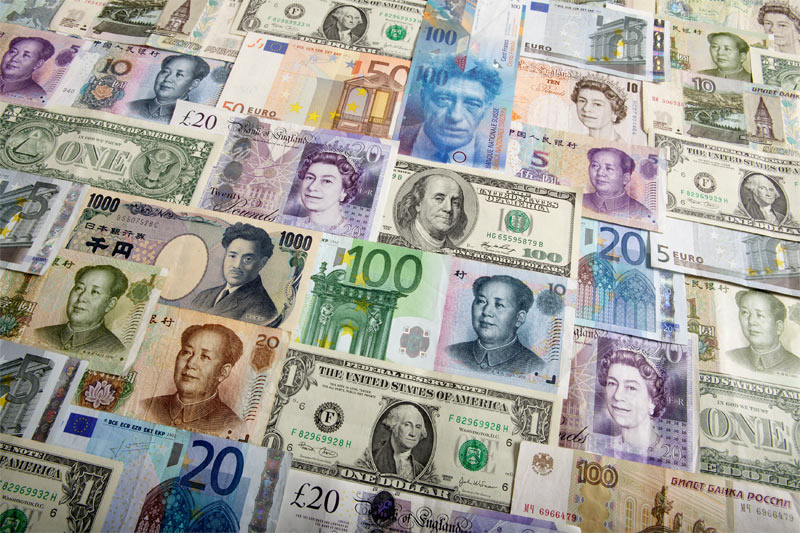Investing.com - The U.S. dollar turned higher against the euro and the yen on Thursday, following the release of better-than-forecast U.S. data on manufacturing and housing.
During U.S. morning trade, the greenback edged higher against the euro, with EUR/USD inching down 0.03% to 1.3222, down from a session high of 1.3296.
The dollar found support after official data showed that manufacturing activity in the Philadelphia-region expanded at the fastest pace in eight months in December.
The Philly Fed manufacturing index rose to 8.1 in December from minus 10.7 in November, compared to expectations for a reading of minus 3.0.
Elsewhere, the National Association of Realtors said that existing home sales rose by 5.9% to a seasonally adjusted 5.04 million units in November. Analysts had expected U.S. existing home sales to rise 2.3% to 4.87 million units.
The dollar hit session lows earlier after revised data showed that the U.S. economy expanded by an annualized 3.1% in the three months to September, up from a preliminary estimate of 2.7% and above expectations for growth of 2.8%.
In a separate report, the U.S. Department of Labor said the number of people who filed for unemployment assistance last week rose by 17,000 to 361,000, compared to expectations for an increase of 13,000 to 357,000.
The dollar erased losses against the yen and re-approached 20-month highs, with USD/JPY inching up 0.03% to 84.43.
The BOJ expanded the size of its asset-purchase program by JPY10 trillion to JPY101 trillion on Thursday, but stopped short of adopting a 2% targeted inflation rate, despite calls from incoming Prime Minister Shinzo Abe for the bank to implement more aggressive measures to combat deflation.
The greenback pulled back from three-month lows against the pound, with GBP/USD easing up 0.09% to 1.6260.
Earlier Thursday, official data showed that U.K. retail sales were flat in November, compared to expectations for a 0.3% increase.
The greenback was trading within striking distance of seven-and-a-half month lows against the Swiss franc, with USD/CHF slipping 0.10% to 0.9123.
The greenback was little changed against its Canadian, Australian and New Zealand counterparts, with USD/CAD dipping 0.05% to 0.9883, AUD/USD inching down 0.05% to 1.0475 and NZD/USD sliding 0.12% to 0.8330.
In Canada, official data showed that retail sales rose 0.7% in October, beating expectations for a gain of 0.1%.
The dollar index, which tracks the performance of the greenback versus a basket of six other major currencies, was down 0.02% to 79.36.
Trade was expected to remain subdued on Thursday, as markets wound down ahead of the Christmas holidays.
During U.S. morning trade, the greenback edged higher against the euro, with EUR/USD inching down 0.03% to 1.3222, down from a session high of 1.3296.
The dollar found support after official data showed that manufacturing activity in the Philadelphia-region expanded at the fastest pace in eight months in December.
The Philly Fed manufacturing index rose to 8.1 in December from minus 10.7 in November, compared to expectations for a reading of minus 3.0.
Elsewhere, the National Association of Realtors said that existing home sales rose by 5.9% to a seasonally adjusted 5.04 million units in November. Analysts had expected U.S. existing home sales to rise 2.3% to 4.87 million units.
The dollar hit session lows earlier after revised data showed that the U.S. economy expanded by an annualized 3.1% in the three months to September, up from a preliminary estimate of 2.7% and above expectations for growth of 2.8%.
In a separate report, the U.S. Department of Labor said the number of people who filed for unemployment assistance last week rose by 17,000 to 361,000, compared to expectations for an increase of 13,000 to 357,000.
The dollar erased losses against the yen and re-approached 20-month highs, with USD/JPY inching up 0.03% to 84.43.
The BOJ expanded the size of its asset-purchase program by JPY10 trillion to JPY101 trillion on Thursday, but stopped short of adopting a 2% targeted inflation rate, despite calls from incoming Prime Minister Shinzo Abe for the bank to implement more aggressive measures to combat deflation.
The greenback pulled back from three-month lows against the pound, with GBP/USD easing up 0.09% to 1.6260.
Earlier Thursday, official data showed that U.K. retail sales were flat in November, compared to expectations for a 0.3% increase.
The greenback was trading within striking distance of seven-and-a-half month lows against the Swiss franc, with USD/CHF slipping 0.10% to 0.9123.
The greenback was little changed against its Canadian, Australian and New Zealand counterparts, with USD/CAD dipping 0.05% to 0.9883, AUD/USD inching down 0.05% to 1.0475 and NZD/USD sliding 0.12% to 0.8330.
In Canada, official data showed that retail sales rose 0.7% in October, beating expectations for a gain of 0.1%.
The dollar index, which tracks the performance of the greenback versus a basket of six other major currencies, was down 0.02% to 79.36.
Trade was expected to remain subdued on Thursday, as markets wound down ahead of the Christmas holidays.
